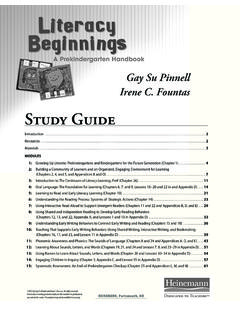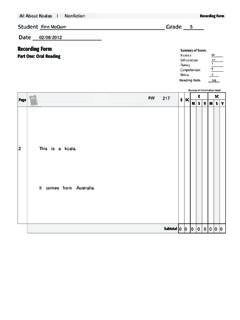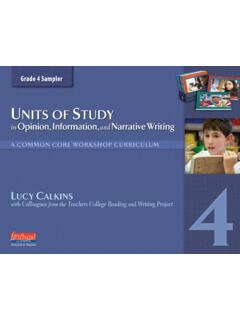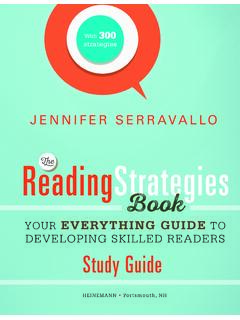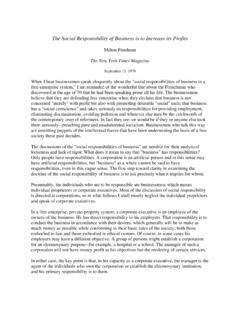Transcription of Grammar for High School - Heinemann
1 HEINEMANNP ortsmouth, NHDON and JENNY KILLGALLONG rammar for High SchoolA Sentence-Composing Approach The Teacher s Booklet2If the new Grammar is to be brought to bear on composition, it mustbe brought to bear on the rhetoric of the sentence.. With hundredsof handbooks and rhetorics to draw from I have never been able towork out a program for teaching the sentence as I find it in the workof contemporary writers. Francis Christensen, A Generative rhetoric of the Sentence * * * *To the memory of Francis Christensen, the first to see the light:Christensen s life s work made possible this program for teaching thesentence as [it is found] in the work of contemporary writers. We aredeeply grateful to him, our silent partner, for helping us work out theprogram found in the sentence-composing approach. Don and Jenny Killgallon3 Background Information4 The purpose and method of the worktextGrammar of the Greats8A list of the sources of the model sentences in the worktextImitation: The Foundation of Sentence Composing17 The rationale for frequent imitation of professional sentencesCreation: The Goal of Sentence Composing18 The connection between sentence imitation and sentence creationSuggestions for Sequencing and Assessing the Worktext19 The scope for one, two, or three grade levels, with suggestions for gradingstudents workTips for Teaching the Sentence-Composing Tools23 General strategies for success in motivating, instructing, and assessingReferences: The Original Sentences33 Model sentences that are the basis for unscrambling, combining, imitating,and expanding practices in the worktextContents4 Background InformationWhenever we read a sentence and like it, we unconsciously store it awayin our model-chamber.
2 And it goes with the myriad of its fellows, to thebuilding, brick by brick, of the eventual edifice which we call our style. Mark TwainLike a building rising brick by brick, writing unfolds one sentence at a time. Thequality of sentences largely determines the quality of writing. The goal of thisworktext is to provide sentence-composing activities to help students build bettersentences. Through imitating model sentences by professional writers and sub-sequently replicating in their own writing the grammatical structures those sentencescontain, students can achieve that composing, an approach developed over thirty years by co-author DonKillgallon, is a unique, eminently teachable rhetoric of the sentence. Its distinguish-ing feature is the linking of the three strands of the English curriculum Grammar ,writing, and literature through exclusive use of literary model sentences for studentsto manipulate, imitate, and replicate in their own research study was conducted (2005 by Don Killgallon) at the University ofMaryland about students perceptions of the structural differences between literarysentences and nonliterary sentences.
3 The conclusion of the study is that, althoughstudents can easily identify literary sentences, they cannot approximate the struc-ture of those sentences in their own students were asked to tell how sentences written by students could be-come more like those by professional writers, a typical response was this: Sentencesof students could become more like the professional ones if the students looked atthe various types of grammatical structures used and tried to duplicate them. Through the activities in Grammar for High School : A Sentence-Composing Approach,teachers will be able to teach students how to build better sentences by learning those various types of grammatical structures and how to duplicate them. Grammar for High SchoolAlthough based on grammatical structures commonly taught in secondary Englishclasses, the sentence-composing approach differs greatly from traditional teachingof Grammar . The activities in Grammar books naming of sentence parts and parsingof sentences dissect dead all your rhetorician s rulesTeach nothing but to name his tools.
4 Samuel Butler, Hudibras5 Grammar for High School : A Sentence-Composing Approach does much more thanname the tools. It teaches students to use those tools to build better sentences throughthe application of Grammar to writing improvement, using rich sentences from lit-erature as models, often from books taught or read independently during the highschool are the differences between sentences from many high School Grammar booksand sentences from literature books, a chasm between artificial sentences concoctedto illustrate subjects, verbs, phrases, clauses ( Grammar books), and real sentences com-posed by effective writers to impact readers (literature books) sentences like the hun-dreds of varied model sentences in this book. (Please see Grammar of the Greats, pages8 16, for a complete list.)Children learn Grammar , including varied sentence structure, by reading goodbooks, picking up literary sentence patterns subconsciously through imitation thesame way they learn to.
5 One purpose of writing is the making of texts, very much the wayone might make a chair or a cake. One way to learn how to make any-thing is to have a model, either for duplication or for triggering one sown ideas. Miles Myers, former director,National Council of Teachers of EnglishTheory and Practice in the Teaching of CompositionA Sentence-Composing ApproachThe hallmark of the approach is the integration of Grammar , writing, and literaturethrough repeated, varied, and systematic practice using only professional sentencesas models for imitation. Sentence-composing practice includes four sentence manipu-lation activities: unscrambling, combining, imitating, Information6 The Four Sentence-Composing TO IMITATE Given a list of scrambled sentence parts of animitation of a model sentence, students unscramble the list to match the struc-ture of the model. Purpose: to break down the imitation task into manageable stepsby isolating the sentence parts of the model.
6 (An example from the worktext is onpage 50.) TO IMITATE Given a list of short sentences, students combinethose sentences to match the structure of the model. Purpose: to convert sentencesinto sentence parts equivalent to those in the model and thereby imitate the structure ofthe model. (An example from the worktext is on page 51.) ALONE After learning how to imitate a sentence, given just a modelsentence, students imitate it by using their own content but the structure of themodel. Purpose: to practice using structures found in professionally written sentencesto internalize those structures for use independently. (An example from the worktextis on page 51.) Given a model sentence with a sentence part deleted at the caretmark (^), students create compatible content and structure to add. Purpose: to prac-tice adding structures found in professionally written sentences. (An example from theworktext is on page 52.)In the development of each of the fourteen tools in this worktext, the four kindsof sentence-composing activities are presented in ascending level of challenge, frommost reliant on the model to least, from imitation (unscrambling, combining, imitat-ing alone) to creation (expanding).
7 Why Sentence Composing WorksSentence composing provides acrobatic training in sentence dexterity. All four sen-tence-composing techniques unscrambling, combining, imitating, expanding useliterature as a School for writing with a faculty of professional in sentence composing and variety stems from two processes, both taughtthrough Grammar for High School : A Sentence-Composing the ability to add structures associated with professionally written sen-tences; the ability to convert structures into ones associated with pro-fessionally written Information7 For both processes, this worktext provides many activities for teaching students tobuild better often much better sentences. Through learning, practicing, and ap-plying the grammatical tools of professional writers, students improve their composing influences the development of unique style. Authors havea signature sentence style that markedly enhances their writing. After exposure to,and imitations of, hundreds of diverse professional sentence styles, many students,with their newly acquired clear understanding of style, will create their own dis-tinctive Information8 Over 200 authors, 250 titles, and 600 sentences are the basis for practices in Grammarfor High School : A Sentence-Composing Approach.
8 The way the best writers of our timeuse the grammatical tools taught in this worktext is the heart and soul of theworktext. Included are model sentences from books read independently by high schoolstudents (J. K. Rowling s Harry Potter series), novels often taught in the senior highgrades (Harper Lee s To Kill a Mockingbird, John Steinbeck s Of Mice and Men, ErnestHemingway s The Old Man and the Sea, William Golding s Lord of the Flies), and of them, listed below, provide a mentorship for students in building better sen-tences, an apprenticeship in learning the Grammar of the greats. Alexander Key, The Forgotten DoorAlexander Petrunkevitch, The Spider and the Wasp Alice Walker, In Search of Our Mothers GardensAnatole France (quotation about writing)Ann Patchett, Bel CantoAnne Morrow Lindbergh, Gift from the SeaAnne Tyler, Back When We Were GrownupsAnne Tyler, Digging to AmericaAnne Tyler, Saint MaybeAnne Tyler, The Amateur MarriageAnnie Dillard, Death of a Moth Annie Dillard, An American ChildhoodAnnie Proulx, Dump Junk Annie Proulx, Man Crawling Out of Trees Annie Proulx, Bad DirtArmstrong Sperry, Call It CourageAudrey Niffenegger, The Time Traveler s WifeBarbara Kingsolver, Animal DreamsBarbara Kingsolver, Pigs in HeavenBarbara Kingsolver, The Bean TreesBarry Commoner, The Politics of EnergyGrammar of the Greats9 Bernard Malamud, The Prison Bernard Malamud, The FixerBill and Vera Cleaver, Where the Lilies BloomBill Brittain, The Wish GiverBruce Catton, The American StoryBruce Catton, Grant and Lee.
9 A Study in Contrasts Carson McCullers, The Heart Is a Lonely HunterCharles Frazier, Cold MountainChristy Brown, Down All the DaysChristy Brown, My Left FootCynthia Rylant, Missing MayD. H. Lawrence, The Prussian Officer Daniel Keyes, Flowers for AlgernonDavid Guterson, Snow Falling on CedarsDavid McCullough, TrumanDeems Taylor, The Monster Diane Ackerman, The Face of Beauty Diane Ackerman, A Natural History of the SensesDonald M. Murray, The Maker s Eye: Revising Your Own Manuscripts Doris Lessing, A Mild Attack of Locusts Dylan Thomas, Quite Early One Morning E. B. White, Once More to the Lake E. Everett Evans, The Shed Edgar Allan Poe, The Fall of the House of Usher Edmund Ware, An Underground Episode Edward Abbey, Aravaipa Canyon Eleanor Coerr, Sadako and the Thousand Paper CranesElizabeth Bowen, Foothold Ellen Goodman, Close to HomeGrammar of the Greats10 Ernest Hemingway, The Snows of Kilimanjaro Ernest Hemingway, A Farewell to ArmsErnest Hemingway, The Old Man and the SeaEugenia Collier, Sweet Potato Pie Evan Connell, Jr.
10 , The Condor and the Guests F. R. Buckley, Gold-Mounted Guns F. Scott Fitzgerald, The Great GatsbyFannie Flagg, Standing in the RainbowFlannery O Connor, The Life You Save May Be Your Own Flannery O Connor, The River Frances Hodgson Burnett, A Little PrincessFrances Hodgson Burnett, The Secret GardenFrank Bonham, ChiefFrank McCourt, Teacher ManFrank Rooney, Cyclist s Raid Franz Kafka, The MetamorphosisGary Soto, Barbie Gaston Leroux, The Phantom of the OperaGeorge Orwell, A Hanging George Orwell, Shooting an Elephant Gerda Weissmann Klein, All But My Life Gina Berriault, The Stone Boy Gregory Clark, A Social Perspective on the Function of WritingGregory David Roberts, ShantaramGwendolyn Brooks, Helen Hal Borland, When the Legends DieHarper Lee, To Kill a MockingbirdHenry Sydnor Harrison, Miss Hinch Ian McEwan, AtonementGrammar of the Greats11 Ian McEwan, Enduring LoveIan McEwan, SaturdayIsabel Allende, Daughter of FortuneIsak Dinesen, The Roads Round Pisa J.
